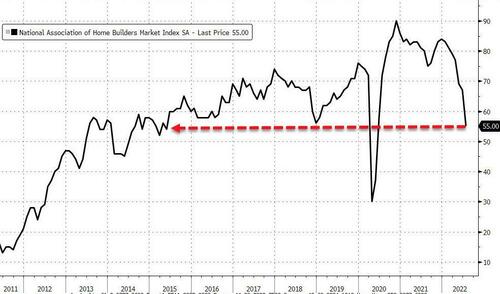Sinkhole
By Philip Marey, senior US strategist at Rabobank
Recession fears weighed on US stock prices yesterday after a report that Apple plans to slow its hiring and spending growth next year in some divisions to cope with a potential economic downturn. This follows recent steps taken by Alphabet, Amazon, Meta and Snap to rein in budgets and decelerate hiring.
While US labor demand is still strong with over 300K nonfarm payroll growth per month, these reports suggest that a slowdown in employment growth is on its way.
Earlier in the day it became clear that US home builder confidence is collapsing. The NAHB housing market index plummeted to 55 in July, from 67 in June.
According to NAHB Chairman Jerry Konter “production bottlenecks, rising home building costs and high inflation are causing many builders to halt construction because the cost of land, construction and financing exceeds the market value of the home.”
The NAHB index has been falling since the start of the year, at the same time that 30 year mortgage rates have risen. Although the Fed started raising policy rates only four months ago, and the target range is still relatively low at 1.50-1.75%, longer-term rates have already risen substantially. Treasury yields (10 year and 30 year) have returned to their peaks of the previous hiking cycle, and 30-year mortgage rates have even risen to levels we have not seen since 2008.
Even in real terms, mortgage rates are higher than in the last decade. This is reducing the affordability of homes, only four months into the Fed’s hiking cycle. This shows how expectations of future policy rate hikes are already finding their way into the economy. Consequently, on top of negative supply shocks and high inflation, households and businesses are now also dealing with much higher interest rates than the current federal funds rate suggests.
Meanwhile, the US treasury yield curve continues to warn us of a recession. More specifically, the 2-10 spread has also turned negative. As we explained in Inversions and recessions, while inversions of the yield curve are seen as harbingers of recession, these warning signals should be interpreted with care.
For example, our econometric analysis shows that the 2-10 spread has to fall below -16bps before the probability of a recession rises above 50%. The 2-10 spread turned negative on June 6, but passed the –16 bps threshold on July 13 after the release of the stronger than expected CPI data.
At present, the spread is –18 bps. This is indicative of a recession 12-18 months ahead, which means the second half of 2023. Note that we have been forecasting a recession for 2023H2 since April. Strengthening our case for a recession, the less popular 1-10 spread – for which we found the threshold to be zero – already turned negative on July 12.
Tyler Durden
Tue, 07/19/2022 – 10:45
via ZeroHedge News https://ift.tt/UHqJW7D Tyler Durden
